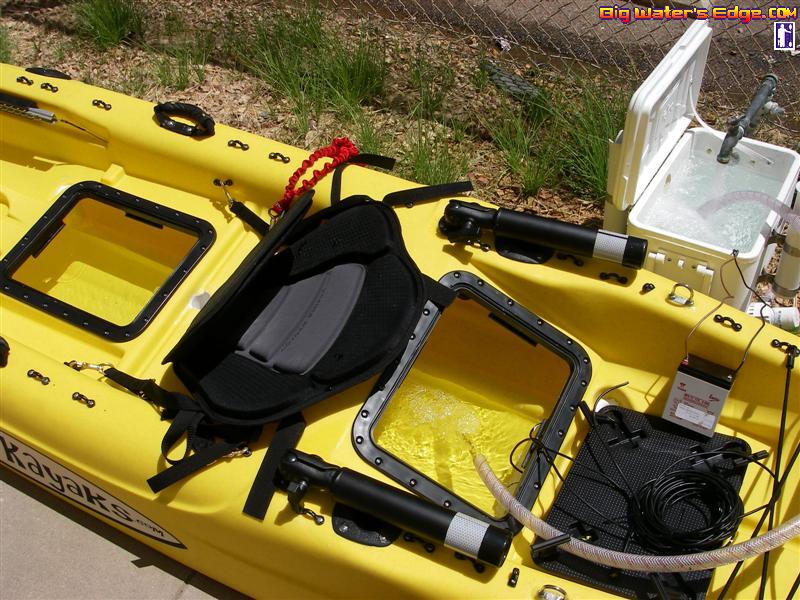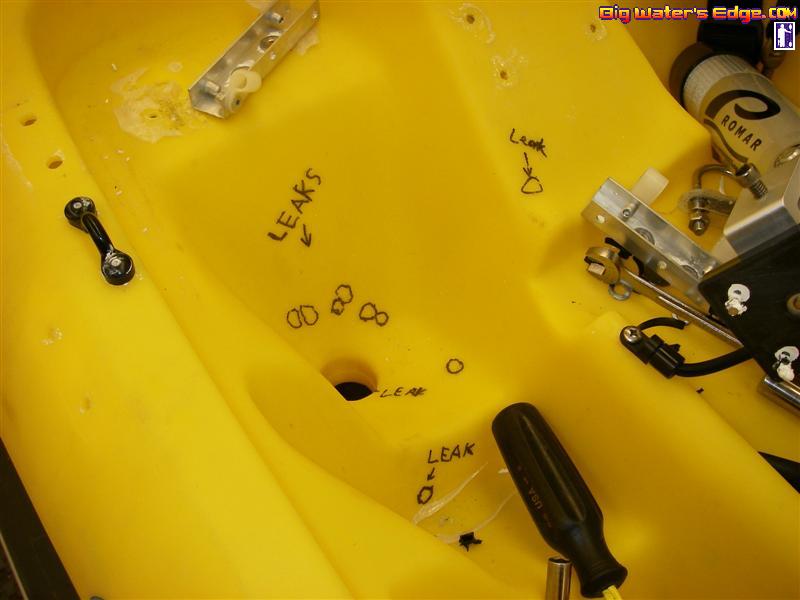
 |
|
|
#1 |
|
Senior Member
Join Date: Jun 2009
Location: Oceanside
Posts: 1,214
|
Leak Tests
keep ending up with 2+ gallons .. Thanks! W |
|
|

|
|
|
#2 |
|
OEX Oceanside
Join Date: Aug 2008
Posts: 113
|
Fill the hull with water and keep an eye on all the scupper holes. Most leaks occur in the scuppers.
__________________
Artist formerly Known as OEX Oceanside   |
|
|

|
|
|
#3 | |
|
Rookie of the Month Club
Join Date: Nov 2008
Location: Mira Mesa
Posts: 483
|
Quote:

__________________
they are getting bigger.... 
|
|
|
|

|
|
|
#4 |
|
Administrator
Join Date: Mar 2005
Location: 1-2 miles off the point
Posts: 6,948
|
First off is the water getting in when launching? 2 gallons sounds around the water line or above. After really eyeballing the whole hull, I plug the scuppers from underneath and pour water into the scuppers from above, come back after a few minutes and see if they are still all full.
__________________
 
|
|
|

|
|
|
#5 |
|
Olivenhain Bob
Join Date: May 2008
Location: Olivenhain, CA
Posts: 1,124
|
Put your kayak on a stand. Fill the kayak with a few inches of water and add some phenol red (available at any pool supply place). Tilt your kayak in various directions until all areas of the hull have been under water for a test period. When you find the place with the leak, it will show up red the outside of the hull. This test will probably not be very good for finding leaks in hatches but it should find any cracks in the hull.
This chemical is not harmful and the color will disappear after a short while. You could also use food coloring but that is a dye that will stain anything it touches. Phenol is much better. Bob |
|
|

|
|
|
#6 |
|
Senior Member
Join Date: Jun 2009
Location: Oceanside
Posts: 1,214
|
i have a old Ocean prowler 15.
seems to happen even on dry launches & Landings.. |
|
|

|
|
|
#7 |
|
Senior Member
Join Date: Mar 2005
Posts: 2,568
|
if it was eX, I was going to say it's a built in feature.
 Gotta hate that leaky hatch. But you gotta love it for storage. Gotta hate that leaky hatch. But you gotta love it for storage.I still love my eX, sorry. It sounds like a leak. Get it fixed it or get a new one. Not safe for operating if it's that consistent. Fill it up with water and put on a dry surface. Never tried, but often read about folks doing that. See if, and where, the water is coming from. Have a water pump on board if you have to go out, have a radio. Carry a sponge - works great. Not to say it is bad idea to have all these things on board even on a perfectly tight and healthy kayak.  
__________________
 [------------------------ [------------------------ <)))< ....b-a-a-a-a |
|
|

|
|
|
#8 |
|
Guerro Grande
Join Date: Jan 2006
Location: Houston, TX
Posts: 629
|
Be careful if you decide to put water in the hull for a leak check. Water is very heavy and if you put too much in an unsupported kayak it may bend or distort the hull.
When I leak check mine I put it on a flat stretch of dry concrete. I use heavy foam blocks at a number of places under the hull to support the weight and keep the kayak stable. This allows me to fill it all the way to the hatches to check as much of the hull as possible. Be very careful when filling to not spill any water outside of the yak. After filling the yak wait for a few minutes and then check underneath for any leakage. Pump out the kayak with a bait tank/bilge pump if you have one. It is a bit of work to do it this way, but it will tell you conclusively if you have leaks.  I would try Andy's method of filling the scuppers first; before you do the whole yak. The scuppers are the most likely culprit. I have also heard of people using soapy water to leak check yaks. You put soapy water all over the yak, seal up all the hatches and then use LOW PRESSURE air to slightly pressurize the hull. It doesn't take much pressure to get a noticeable stream of bubbles off a leak. Of course you'll get leaks at hatches and any designed hull pass-throughs, but you're looking for holes in the wrong places; below the waterline. I had a Prowler 15 that had a ton of pinhole leaks that were hard to find.  They didn't start passing much water at first, but after a few minutes they would have steady rivulets of water running out. OK gave me a new P15 without much hassle. I learned my lesson though; always leak check a rotomolded vessel before going out on the water. That leaky kayak cost me a lot of money in lost gear.
__________________
Douglas Gaxiola  Team No Fish- Amateur Staff Team No Fish- Amateur Staff |
|
|

|
|
|
#9 |
|
Senior Member
Join Date: May 2007
Location: Clairemont
Posts: 116
|
I had a scupper leak in my first P-13 several years ago (2005). Apparently it was a pretty common occurrence on the older prowlers and OK subsequently fixed them. I filled mine with water and as you can see the leak was very evident. OK replaced mine no problem with a newer model.
|
|
|

|
|
|
#10 | |
|
Señor member
Join Date: Mar 2005
Location: San Diego, CA
Posts: 1,627
|
Quote:
|
|
|
|

|
|
|
#11 |
|
greenscales
Join Date: Jul 2005
Location: Monrovia
Posts: 116
|
Air instead of water
I had a lot of problems solving similar problems with my kayak--and after 10 years it is the driest it has ever been.
Diagnostics - you need access to an air compressor then get soapy water and a rag or sponge. Keep everything sealed except your drain plug. Soap up all seals around hatches, if you have any other known holes (like for transducer wires) cover them with duct tape, then blow air in the drain plug. You may need a second person to do this while you use the soapy water to recover all of the seals and look for bubbles. If you have any leak issues, the bubbles will be apparent. If none show, then hit the scupper holes and other likely areas. If still nothing shows - then definitely get a second person and cover the whole kayak with the soap and water. Once you determine where the leak is located, then re-post and you will get a bunch of fix recommendations. If you still do not find the source of the leak, then at least you now have a clean kayak. Good luck. |
|
|

|
|
|
#12 |
|
Junior
Join Date: May 2009
Posts: 13
|
Bring that fish killer up to us in Oside Jay!
|
|
|

|
|
|
#13 |
|
Senior Member
Join Date: Mar 2005
Location: San Diego CA
Posts: 947
|
The most common areas for leaks on the older Prowlers were the scuppers, keel line from dragging and, depending on year of boat, the rudder attachment point. I would start with the scuppers. Often you can see the leak point upon a simple visual inspection. If not Duct tape closed the bottom of the scuppers so they are basically a cup. Fill them with water, soapy water is better. Make sure all hatches are closed then do the air pressure test, as described above, through the drain hole. If you do not have a compressor a battery operated pump for air mattresses works great and usually has a fitting that will wedge right into the drain hole.
__________________
Jim Sammons La Jolla Kayak Fishing The Kayak Fishing Show JimSammons.com 
|
|
|

|
|
|
#14 |
|
Senior Member
Join Date: Jun 2009
Location: Oceanside
Posts: 1,214
|
I wish I had some fish left man!...
I only have one bug left as far as the food goes.. Dont ever say that phuckin' filthy six letter "F" word!..  (note to self..get out soon & get me some fresh dinner!..) _______ I'm going to soap test it now & see..Thanks! will post the next trouble shooting stage asap.. cross your fingers and not my lines.. |
|
|

|
 |
| Thread Tools | |
| Display Modes | |
|
|